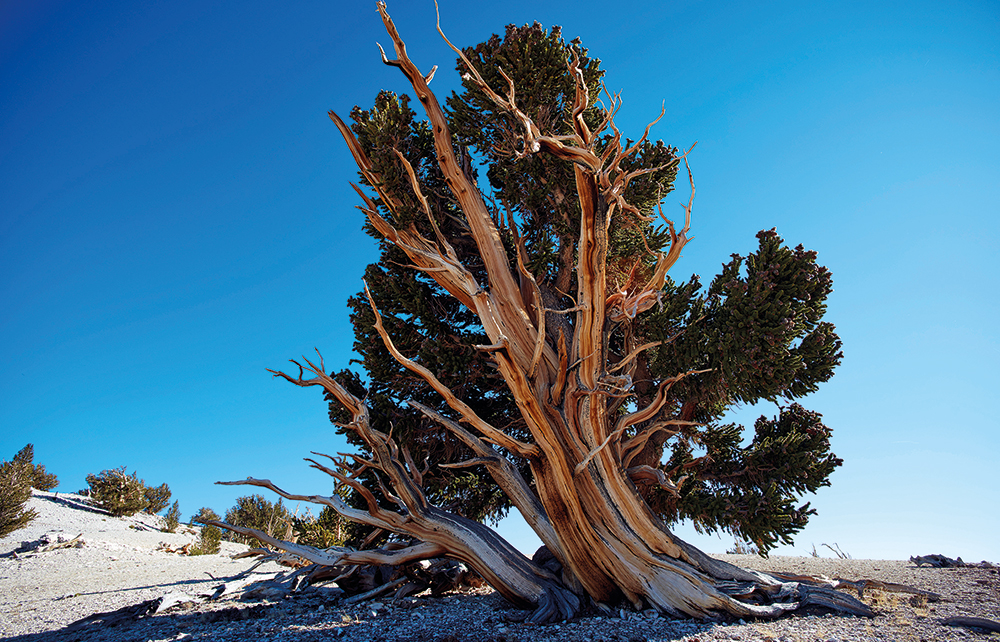It is perhaps easy to understand why some of the Earth’s largest trees, with roots spreading deep into the underworld as their upper limbs ascend to heaven, are charged with symbolic importance. Yet the origins of our fixation are perhaps surprising. To give one example, the Buddha was said to have attained enlightenment beneath the spreading limbs of a bodi, or pipal tree. That same specimen still reputedly flourishes at Bodh Gaya in Nepal. Even earlier, the first temple of Jerusalem was constructed from timbers King Solomon obtained specifically from the cedars of Lebanon, whose own sacred status recedes into the mists of prehistory.
Elderflora – a name coined by Jared Farmer for these venerable old masters – suggests that little has changed since Solomon’s time. We are still awestruck by such trees’ longevity. We entwine them with exciting new stories, but continue to recycle the legends. Farmer sets out to capture all this in a series of arboreal biographies that are global in scope.
A group of trees still living, known as gymnosperms, long predate the dinosaurs
He points out that only certain trees (including the ginkgo, cedar, redwood, cypress, araucaria and pine) have the potential for great age. They in turn belong to a group known as gymnosperms, which are among the earliest trees to have evolved. They not only long predate the dinosaurs but have outlasted the depredations of every kind of grazing predator; and herein perhaps lies the clue to their success. The tougher the conditions, the longer they seem to survive. The supreme example is the bristlecone pine, growing in the mountains of Utah, where some colonies enjoy a growing season of just 45 days in every year. Yet they have tolerated extreme levels of ecological poverty for five millennia and possibly more.
Farmer is good at drawing out these contradictions; but a fact he barely touches on is that some trees do remarkably well with persistent human care. Chestnuts, oaks and olives are among the most enduring of Europe’s trees and invariably reach their greatest ages when continuously cultivated. They are also the elderflora that have helped mankind the most. Sweet chestnuts were a mainstay of the Italian rural diet for 1,000 years; oak acorns have long been crucial to pig-rearing; and olives were perhaps the defining crop of an entire civilisation.
Farmer tackles only the last, in a relatively short chapter; though, to be fair, olives are not in the elderflora super league. But a British tree that definitely qualifies is the yew. The species has a complex connection to churchyards, with 95 per cent of Welsh and 55 per cent of English yews growing in religious settings, while one example in Perthshire is thought to be 4,000 years old. An explanation for the yew’s church-going habits drew on the belief that its roots could mop up the decay associated with graveyards. But the theory ran foul of the fact that many yews not only predate their adjacent grounds, but are older than Christianity itself.
Farmer provides an excellent summary of this lore; but what really seems to excite him is a sequence of ancient trees running in a wide arc around the Pacific region, including the cypresses of Taiwan and Japan, the old-growth indigenous kauri forests of New Zealand and the giant endemic trees in Chile known as alerces. He returns finally to devote more than a third of the book to the two ultimate elderflora representatives. They are the giant sequoias of the Californian mountains, which are the most massive organisms ever to have lived, and to the bristlecone pines of California and Utah, strong contenders for being the planet’s longest-lived trees.
These interlocking narratives allow Farmer to incorporate in his story cycle an account of the extraordinary researcher Edmund Schulman. This indefatigable and ironically short-lived man established the science of dendrochronology on solid foundations. He was among the first to recognise that growth rings in old trees offered clear evidence of wider atmospheric conditions. He died, aged 49, in 1958, the same year that David Keeling began research in Hawaii which provided incontrovertible evidence that humanity was altering both the levels of atmospheric carbon and the planet’s climate.
A central paradox unfolds in this long history of ancient trees: that we have truly discovered their importance in lockstep with our capacity to destroy them. It includes the story of turning the majestic kauri in New Zealand and the Californian redwoods into industrial lumber and roof shingles. But beyond that there’s the more troubling possibility: that all these grand old trees, whose living roots predate the Buddha and King Solomon, could be lost as the Earth burns. They are grand themes, and Farmer deserves credit for weaving such complex and disparate materials into his narrative whole.






Comments